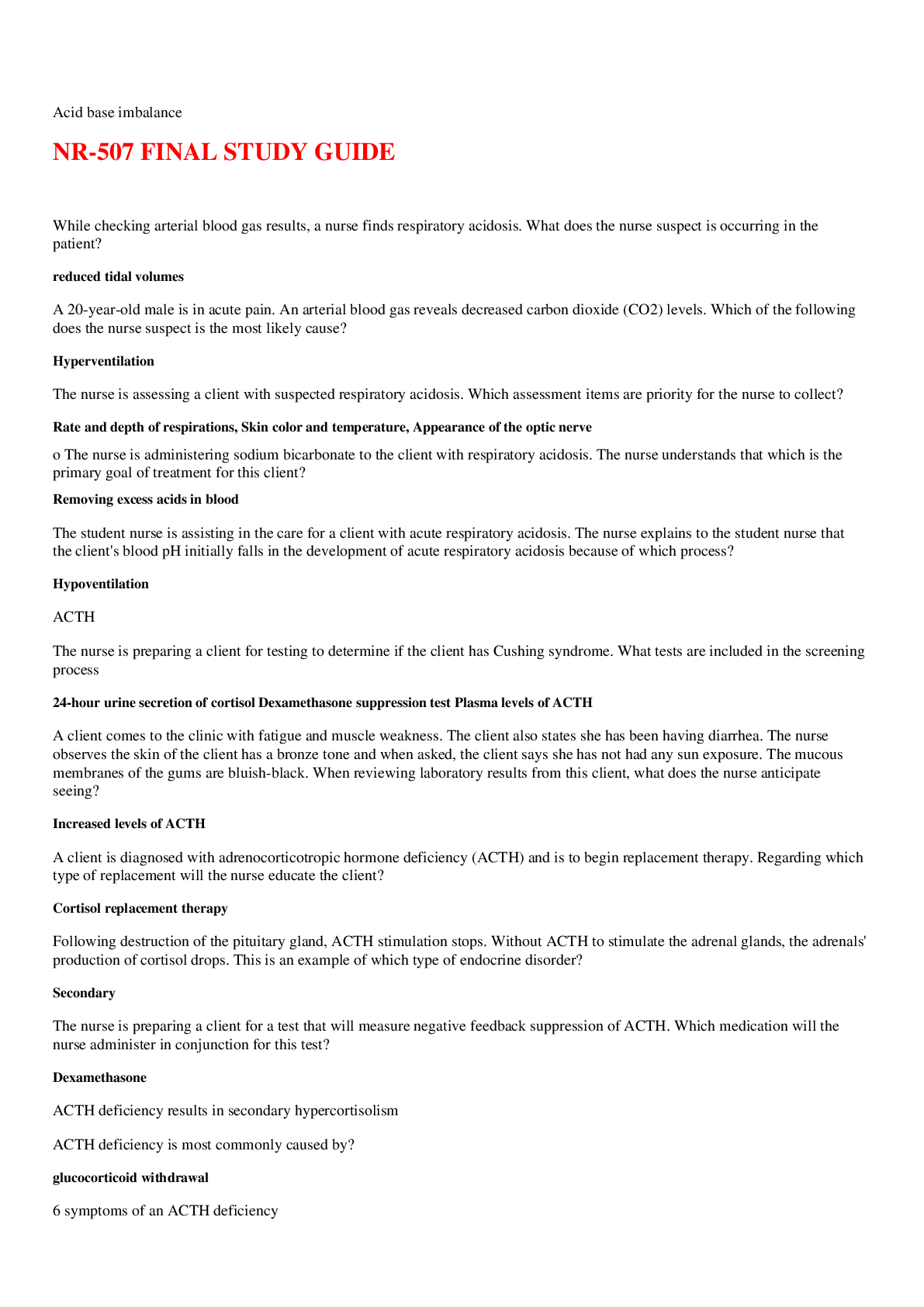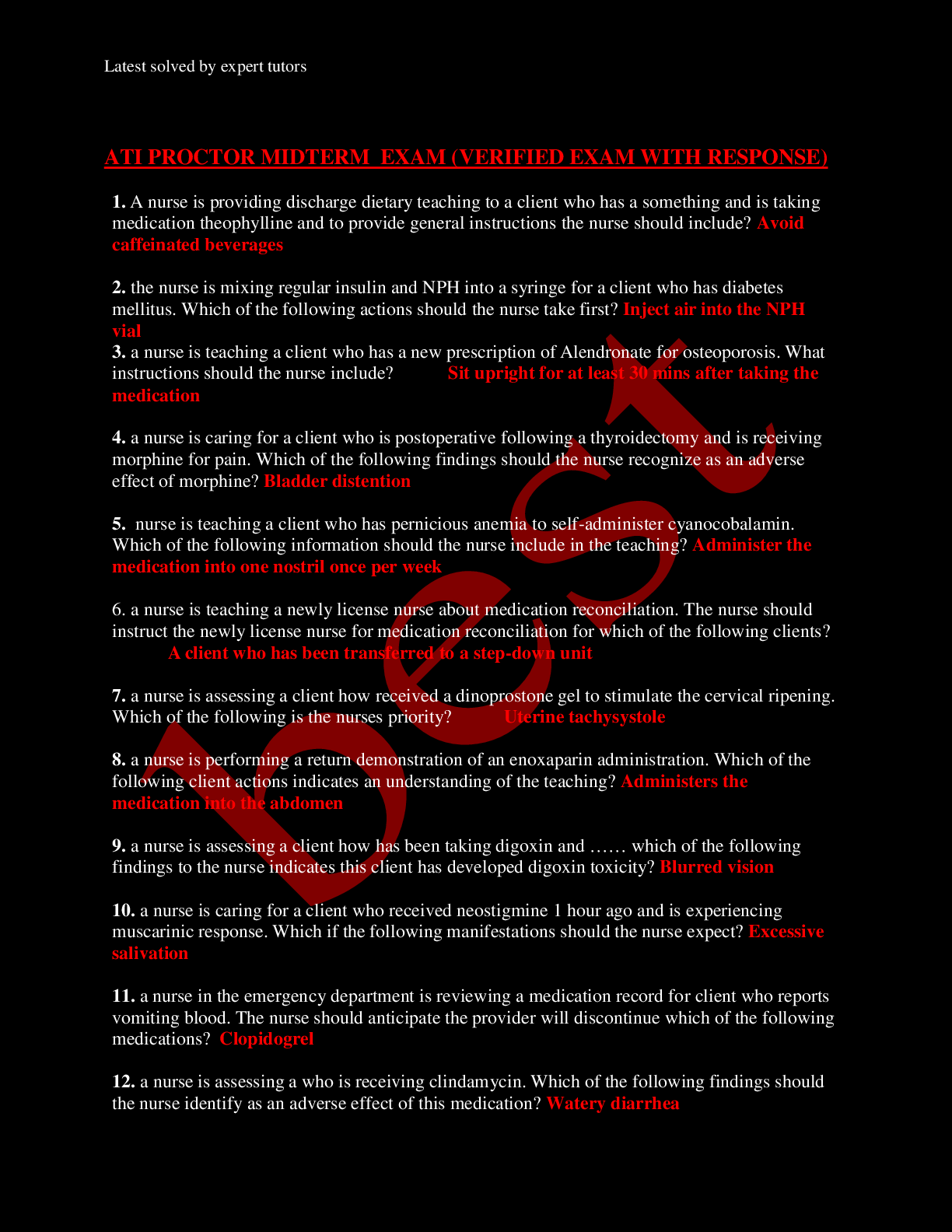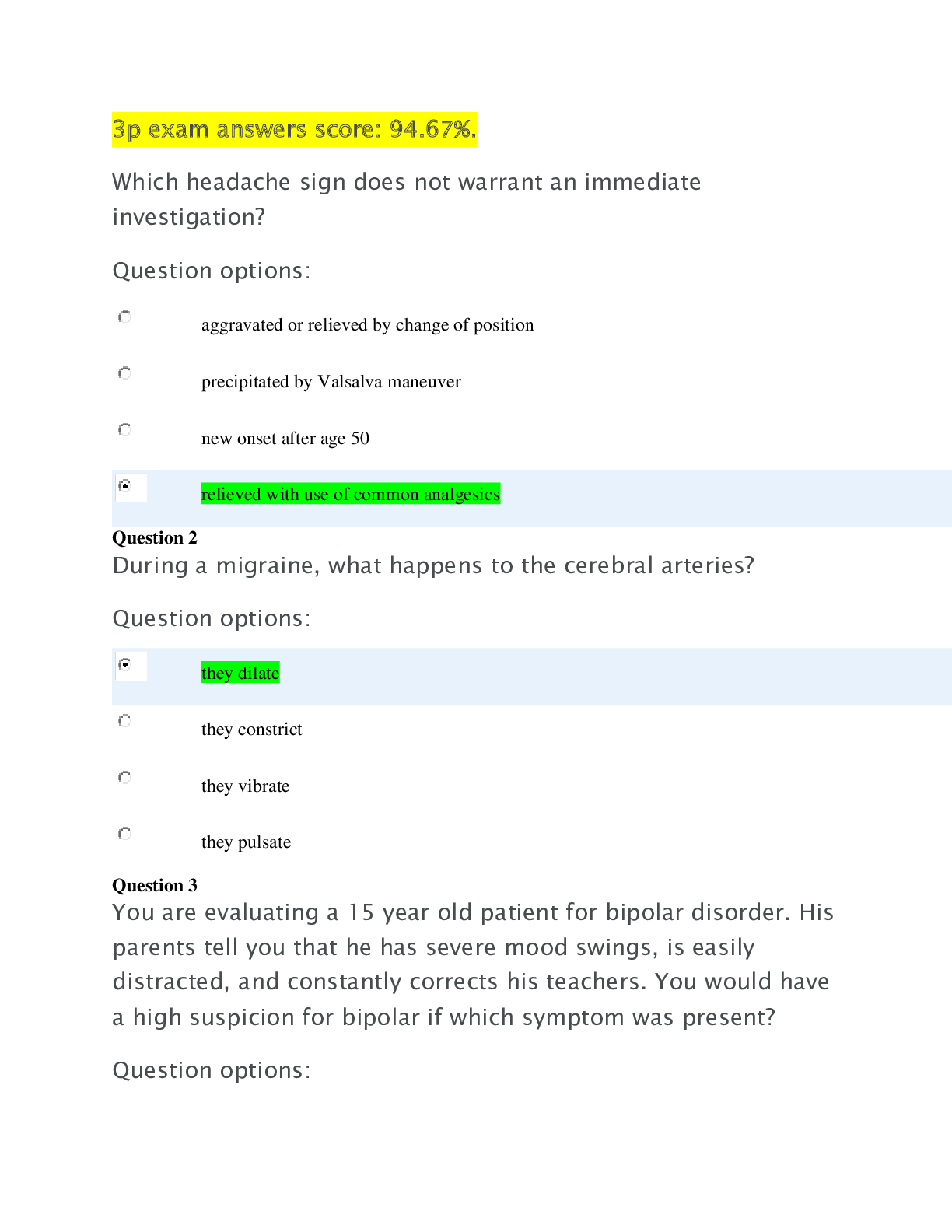*NURSING > EXAM > AGNP BOARD EXAM QUESTIONS Cardiovascular Assessment (107 Questions and Answers) (All)
AGNP BOARD EXAM QUESTIONS Cardiovascular Assessment (107 Questions and Answers)
Document Content and Description Below
AGNP BOARD EXAM QUESTIONS Cardiovascular Assessment (107 Questions and Answers) 1.Question: The preauricular nodes drain lymphatic fluid from the: palpebral conjunctiva and the skin adjacent... to the ear within the temporal region. Correct eyelids, the conjunctiva, and the skin and mucous membrane of the nose and cheek. mouth, throat, and face. posterior part of the temporoparietal region. Explanation: The preauricular nodes drain lymphatic fluid from the palpebral conjunctiva as well as the skin adjacent to the ear within the temporal region. Tonsillar, submandibular, and submental nodes (anterior and superficial cervical lymph nodes) drain lymphatic fluid from portions of the mouth , throat, and face. The facial lymph nodes (infraorbital or maxillary, buccinator, and supramandibular) drain lymphatic fluid from the eyelids, the conjunctiva, and the skin and mucous membranes of the nose and cheek. The posterior auricular lymph nodes drain lymphatic fluid from the posterior part of the temporoparietal region. 2.Question: When auscultating the heart, the displacement of the point of maximal impulse (PMI) is greater than 10 cm lateral to the midsternal line. This finding is consistent with: right ventricular hypertrophy. left ventricular hypertrophy. Correct pulmonary stenosis. a normal PMI location. Explanation: Displacement of the PMI lateral to the midclavicular line or greater than 10 cm lateral to the midsternal line suggests left ventricular hypertrophy (LVH). 3.Question: When auscultating the heart of a 55-year-old patient, a loud murmur with a thrill is audible in the right second intercostal space that radiates to the carotid arteries. Also noted is a crescendo-decrescendo pitch audible at the apex. The murmur is heard best with the patient sitting and leaning forward. This finding is consistent with: pulmonic stenosis. tricuspid regurgitation. mitral regurgitation. aortic stenosis. Correct Explanation: With aortic stenosis, the murmur is audible loudest in the right second intercostal space and radiates to the carotid arteries, down the left sternal border, or the apex. There is a crescendo-decrescendo pitch audible at the apex. The murmur is heard best with the patient sitting and leaning forward. The murmur audible with pulmonic stenosis produces a soft intensity with a crescendo-decrescendo pitch. It is loudest at the second or third intercostal spaces and radiates to the left shoulder and neck. With tricuspid regurgitation, the murmur is audible loudest at the left sternal border with radiation to the right sternal border, xiphoid area, or to the left midclavicular line. It produces a blowing sound and is pansystolic. The intensity may increase with inspiration. Mitral regurgitation produces a pansystolic, harsh murmur heard loudest at the apex with radiation toward the left axilla. The intensity of the murmur can be soft, or if there is an atrial thrill, it can be loud. 4. Question: A disease that may present as indigestion, but is precipitated by exertion and relieved by rest is most likely: gastroesophageal reflux. inflammatory bowel disease. angina. Correct aortic stenosis. Explanation: A disease that may present as indigestion, but is precipitated by exertion and relieved by rest is most likely angina. Question: Causes of orthostatic hypotension in older adults may include all of the following except: diabetes. cardiovascular disorders. medications. impaired visual acuity. Correct Explanation: Orthostatic hypotension occurs in 20% of older adults and in up to 50% of frail nursing home residents, especially when they first arise in the morning. Causes include medications, autonomic disorders, diabetes, prolonged bed rest, volume depletion, amyloidosis, and cardiovascular disorders. Impaired visual acuity is not a cause of orthostatic hypotension but can be a resulting symptom. Question: To auscultate the heart sounds arising from the pulmonic valve in an adult patient, place the stethoscope: near the apex of the heart between the 5th and 6th intercostal spaces in the mid-clavicular line. between the 2nd and 3rd intercostal spaces at the right upper sternal border. between the 2nd and 3rd intercostal spaces at the left sternal border. Correct between the 3rd, 4th, 5th, and 6th intercostal spaces at the left lower sternal border. Explanation: Auscultation should proceed in a logical manner over 4 general areas on the anterior chest, beginning with the patient in the supine position and using the diaphragm of the stethoscope. The mitral listening point is near the apex of the heart between the 5th and 6th intercostal spaces in the mid-clavicular line. The aortic listening point is between the 2nd and 3rd intercostal spaces at the right upper sternal border (RUSB). The pulmonic listening point is located between the 2nd and 3rd intercostal spaces at the left sternal border (LUSB). The tricuspid listening point is between the 3rd, 4th, 5th, and 6th intercostal spaces at the left lower sternal border (LLSB). Question: A sudden, tearing, sharp pain that begins in the chest and radiates to the back or into the neck is usually associated with: angina pectoris. a myocardial infarction. an aortic dissection. Correct pericarditis. Explanation: Assessing chest pain can be very difficult but a thorough patient history and physical exam can help the clinician determine a likely cause. A sudden sharp pain that radiates to the back or into the neck is usually associated with aortic dissection. Exertional pain can be angina pectoris. Symptoms most often seen with myocardial infarction include a retrosternal type pain that often radiates up to the neck, shoulder, and jaw and down to the ulnar aspect of the left arm. Pain associated with pericarditis may radiate to the tip of the shoulder and to the neck and presents with a sharp knifelike pain. Any pain in the chest is cardiac until proven otherwise. Question: A 68-year-old man with uncontrolled hypertension presents with sudden, intense left lower abdominal pain that radiates to the back. The pain is associated with a tearing sensation. These findings are MOST likely associated with: cholecystitis. an abdominal aortic aneurysm (AAA). Correct perforated gastroesophageal (GI) ulcer. nephrolithiasis. Explanation: Sudden, intense left lower abdominal pain that radiates to the back with a “tearing” sensation are symptoms of abdominal aortic aneurysm (AAA). For the diagnosis of a possible rupturing AAA, outpatient CT scan, abdominal ultrasound, and angiography testing are NOT recommended. The patient should be referred to the emergency department for acute assessment and treatment. Question: A condition that usually presents with numbness or tingling in the distal portions of one or more fingers aggravated by cold or emotional stress may be associated with: neurogenic claudication. intermittent claudication. atherosclerotic peripheral vascular disease. Raynaud's disease. Correct Explanation: Raynaud's disease may present with numbness or tingling in the distal portions of one or more fingers aggravated by cold or emotional stress. Pain or cramping in the legs that occurs with exertion and is relieved by rest is termed intermittent claudication. Atherosclerotic peripheral artery disease presents with symptomatic limb ischemia with exertion. Pain with walking or prolonged standing, radiating from the spinal area into the buttocks, thighs, lower legs, or feet, may be seen in neurogenic claudication. Question: A twelve-month-old has a history of heart failure related to his congenital heart defect. He is receiving aldactone (Spironolactone), enalapril (Vasotec), furosemide (Lasix), and acetaminophen (Tylenol). The infant's potassium level is 3.1 meq/l. Which medication is most likely decreasing his potassium level? Aldactone (Spironolactone) Furosemide (Lasix) Correct Enalapril (Vasotec) Acetaminophen (Tylenol) Explanation: Loop diuretics can produce decreased potassium levels. Lasix is a loop diuretic. Potassium levels considered WNL by most labs range between 3.5 and 5.3 meq/l; so 3.1 meq/l is considered low and may need to be adjusted. The other medications are not known for excessive potassium losses. Question: The posterior auricular lymph node is located: at the angle of the mandible. in front of the ear. at the base of the skull posteriorly. superficial to the mastoid process. Correct Explanation: The posterior auricular nodes are superficial to the mastoid process. The preauricular lymph nodes are located in front of the ear. The tonsillar lymph nodes are at the angle of the mandible. The occipital lymph nodes are located at the base of the skull posteriorly. Question: A patient complains of a tight, bursting pain in the calf that increases with walking. Elevation of the leg sometimes relieves the pain. These symptoms may be consistent with: intermittent claudication. Raynaud's disease. deep venous thrombosis. Correct superficial thrombophlebitis. Explanation: Deep venous thrombosis (DVT) is a venous disorder. The patient often describes the pain as tight, and bursting around the affected area. The pain may be accompanied by swelling and tenderness. Reynaud's disease usually affects the distal portions of the fingers and causes pain especially with exposure to cold or stress. Episodic muscular ischemia induced by exercise, due to atherosclerosis of large or medium-sized arteries, is defined as intermittent claudication. The pain is usually associated with the calf muscles, but also may be in the buttock, hip, thigh, or foot, depending on the level of obstruction. Rest usually stops the pain within a few seconds. Question: A patient complains of pain in the arch of the foot sometimes relieved by rest. Occasionally, he experiences intermittent pain in the toes, especially at rest. Exercise aggravates the pain in the arch. History reveals he smokes approximately a half pack of cigarettes per day. These symptoms may be consistent with: intermittent claudication. Raynaud's disease. deep venous thrombosis. thromboangiitis obliterans. Correct Explanation: Thromboangiitis obliterans or Buerger's disease, is defined as inflammatory and thrombotic occlusions of small arteries and also of veins, usually occurring in smokers. Symptoms include intermittent claudication especially in the arch of the foot and pain at rest in the toes or fingers. Other symptoms may include distal coldness or cyanosis. Episodic muscular ischemia induced by exercise, due to atherosclerosis of large or medium-sized arteries, is defined as intermittent claudication. The pain is usually associated with the calf muscles, but also may be in the buttock, hip, thigh, or foot, depending on the level of obstruction. Rest usually stops the pain within a few seconds. Reynaud's disease usually affects the distal portions of the fingers and causes pain especially with exposure to cold or stress. Deep venous thrombosis (DVT) is a venous disorder and the pain is tight, and bursting often in the calf. The pain may be accompanied by swelling and tenderness. Question: In older adults, the presence of heart sound S3 suggests: hypertension. heart failure. Correct an aortic aneurysm. aortic stenosis. Explanation: In older adults, an S3 suggest dilatation of the left ventricle from heart failure or cardiomyopathy. S3 is produced when blood strikes a compliant left ventricle. It commonly accompanies fluid overload. It may be normal in children or pregnant women. Question: The posterior chest wall and portions of the arms are drained by which group of lymph nodes? Posterior mediastinal nodes Subscapular nodes Correct Parasternal nodes Intercostal nodes Explanation: The subscapular lymph nodes drain lymphatic fluid from the posterior chest wall and a portion of the upper arms. The posterior mediastinal lymph nodes drain lymphatic fluid from the esophagus and posterior part of the pericardium. The lymph nodes of the chest wall include the parasternal, intercostal and the diaphragmatic areas. The parasternal lymph nodes drain the medial half of the breasts. The posterior-lateral aspect of the chest is drained by the intercostal lymph nodes. The diaphragmatic nodes drain the upper surface of the diaphragm. Question: In older adults, the presence of heart sound S4 suggests: hypertension. Correct heart failure. an aortic aneurysm. aortic stenosis. Explanation: An S4 heart sound occurs when the atria contract and force blood into a left ventricle that is non-compliant. This can be the result of diastolic heart failure, hypertension, infraction, or others. It is known as the "atrial gallop". This is always abnormal. ............Continued [Show More]
Last updated: 1 year ago
Preview 1 out of 46 pages
Instant download
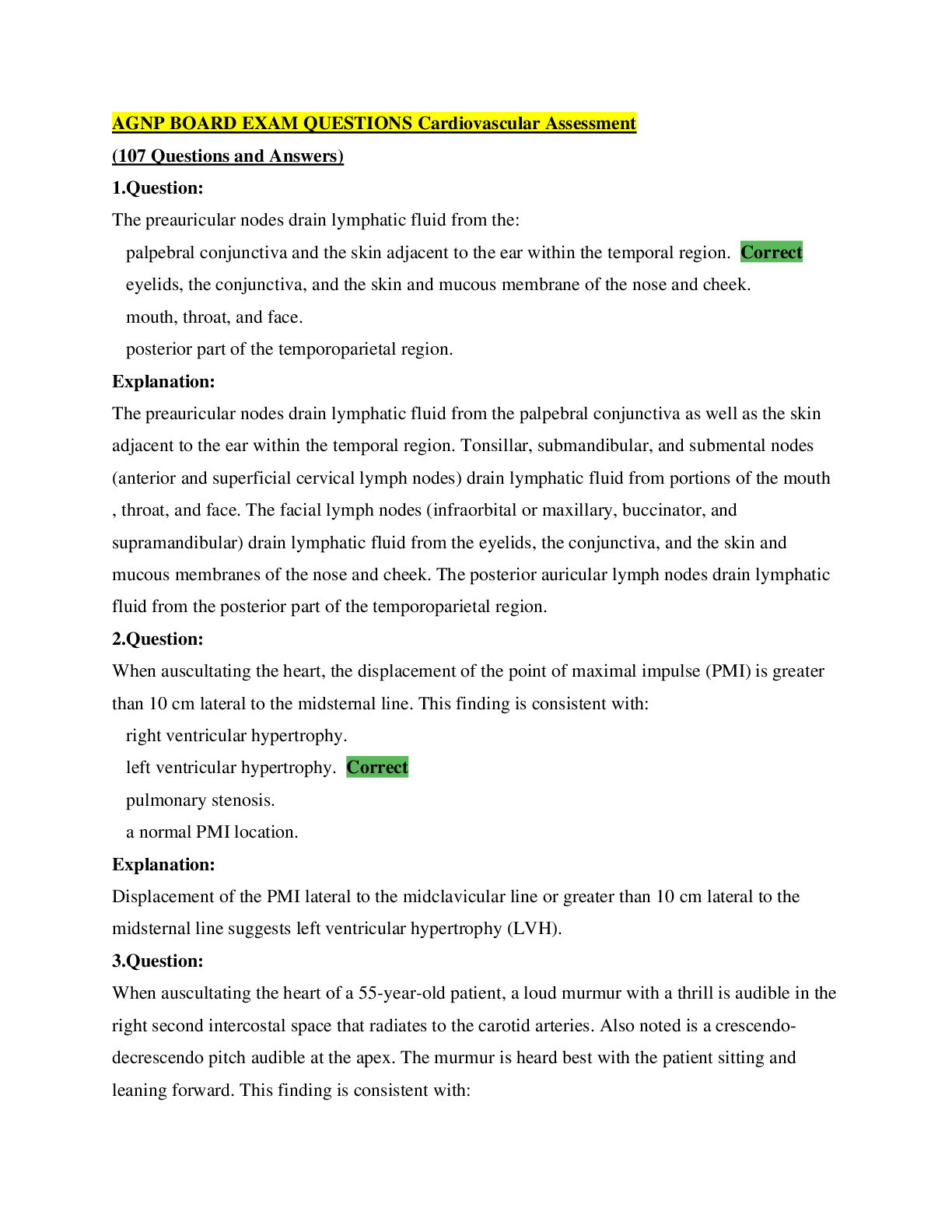
Buy this document to get the full access instantly
Instant Download Access after purchase
Add to cartInstant download
Also available in bundle (1)
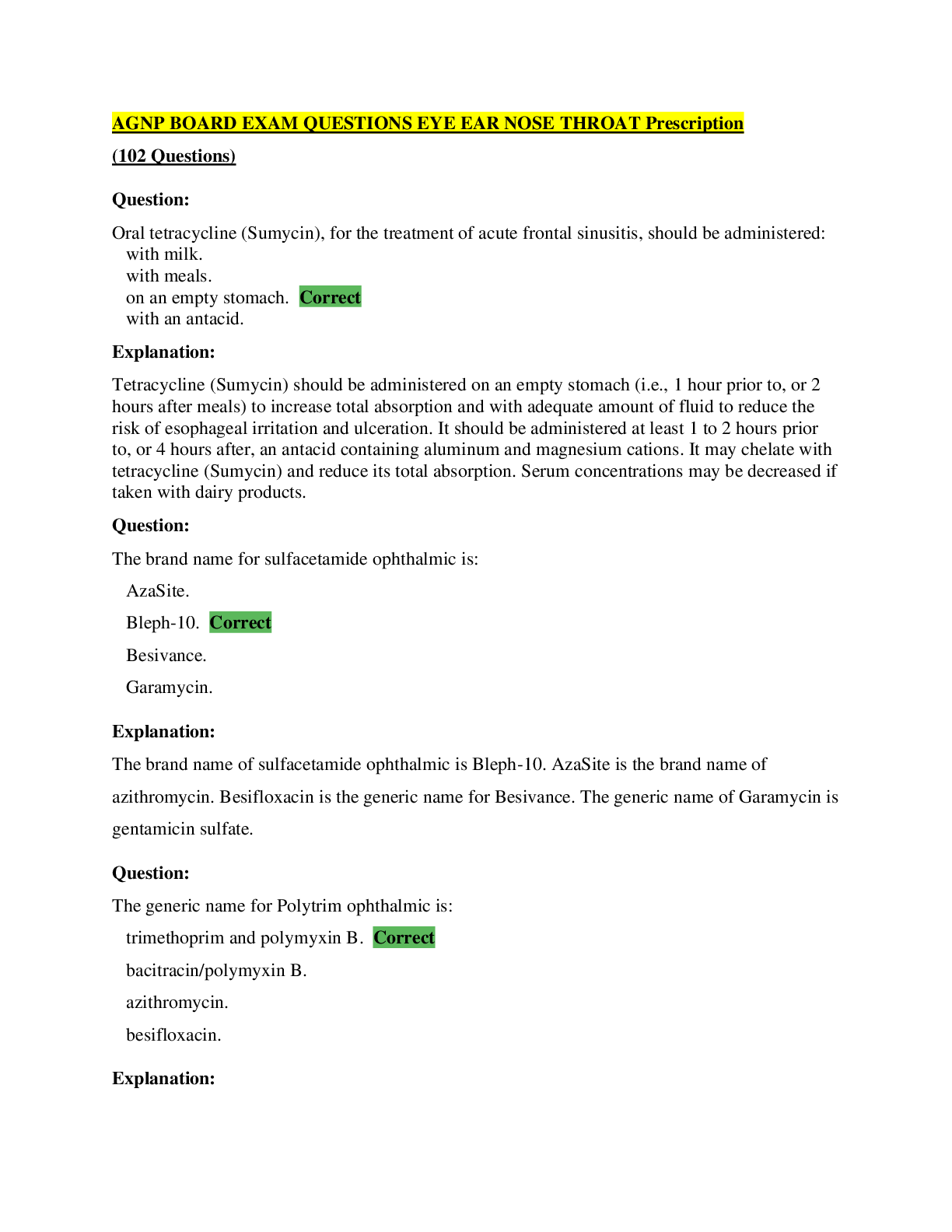
AGNP BOARD EXAMS (23 Different Versions) ; Questions and Answers
AGNP BOARD EXAMS (23 Different Versions) ; Questions and Answers
By YourTutor 3 years ago
$95.5
23
Reviews( 0 )
Document information
Connected school, study & course
About the document
Uploaded On
Feb 01, 2021
Number of pages
46
Written in
Additional information
This document has been written for:
Uploaded
Feb 01, 2021
Downloads
0
Views
54

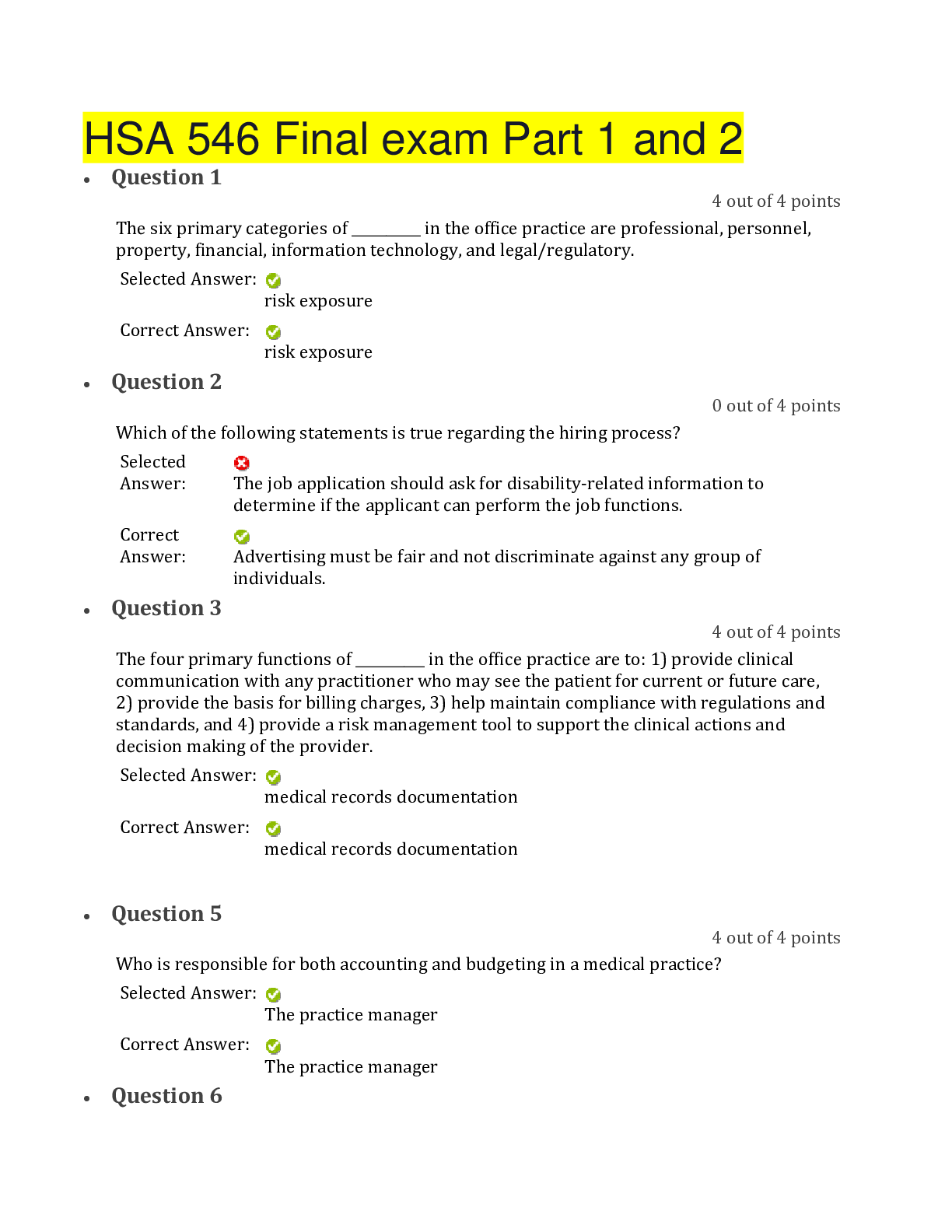


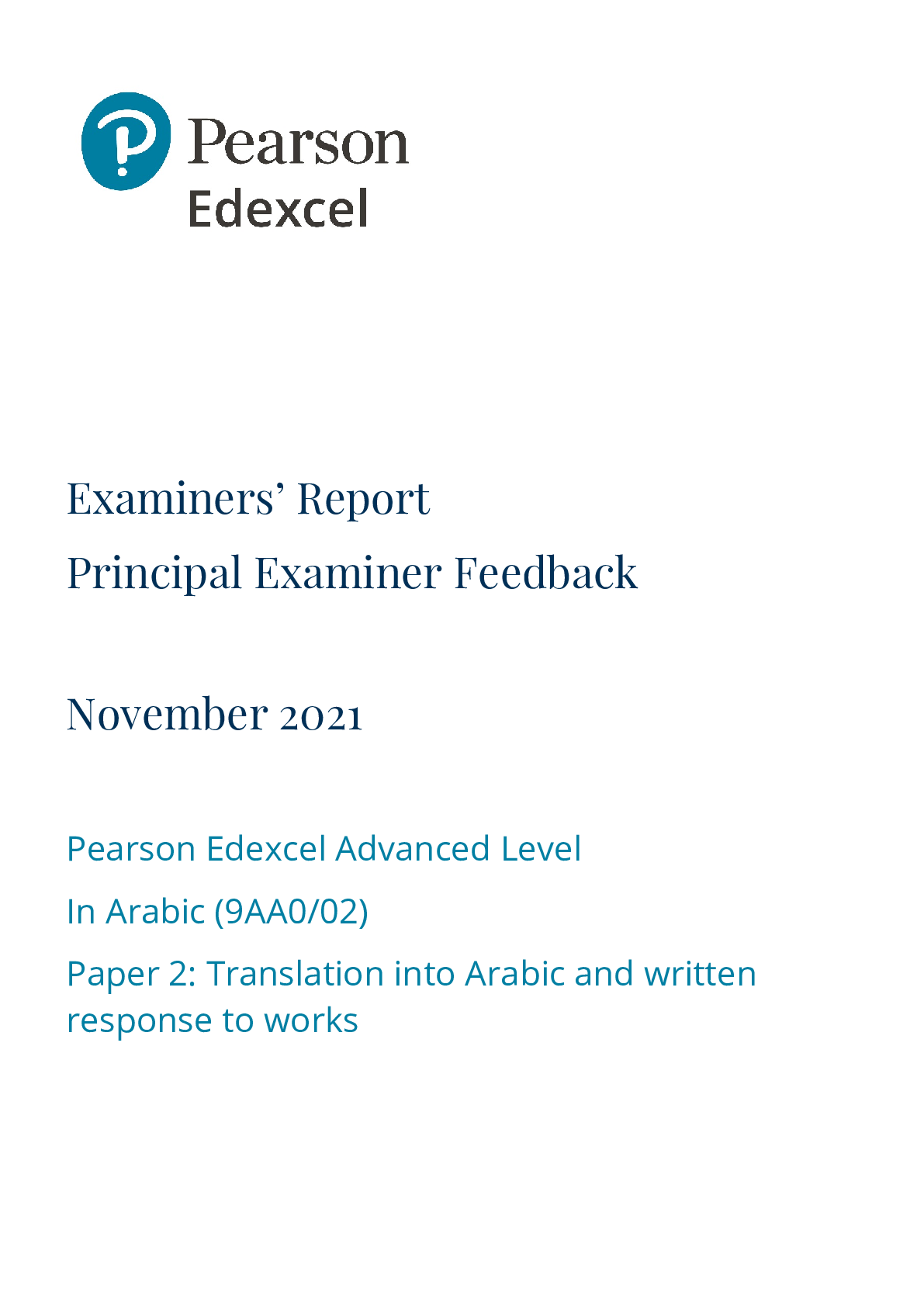

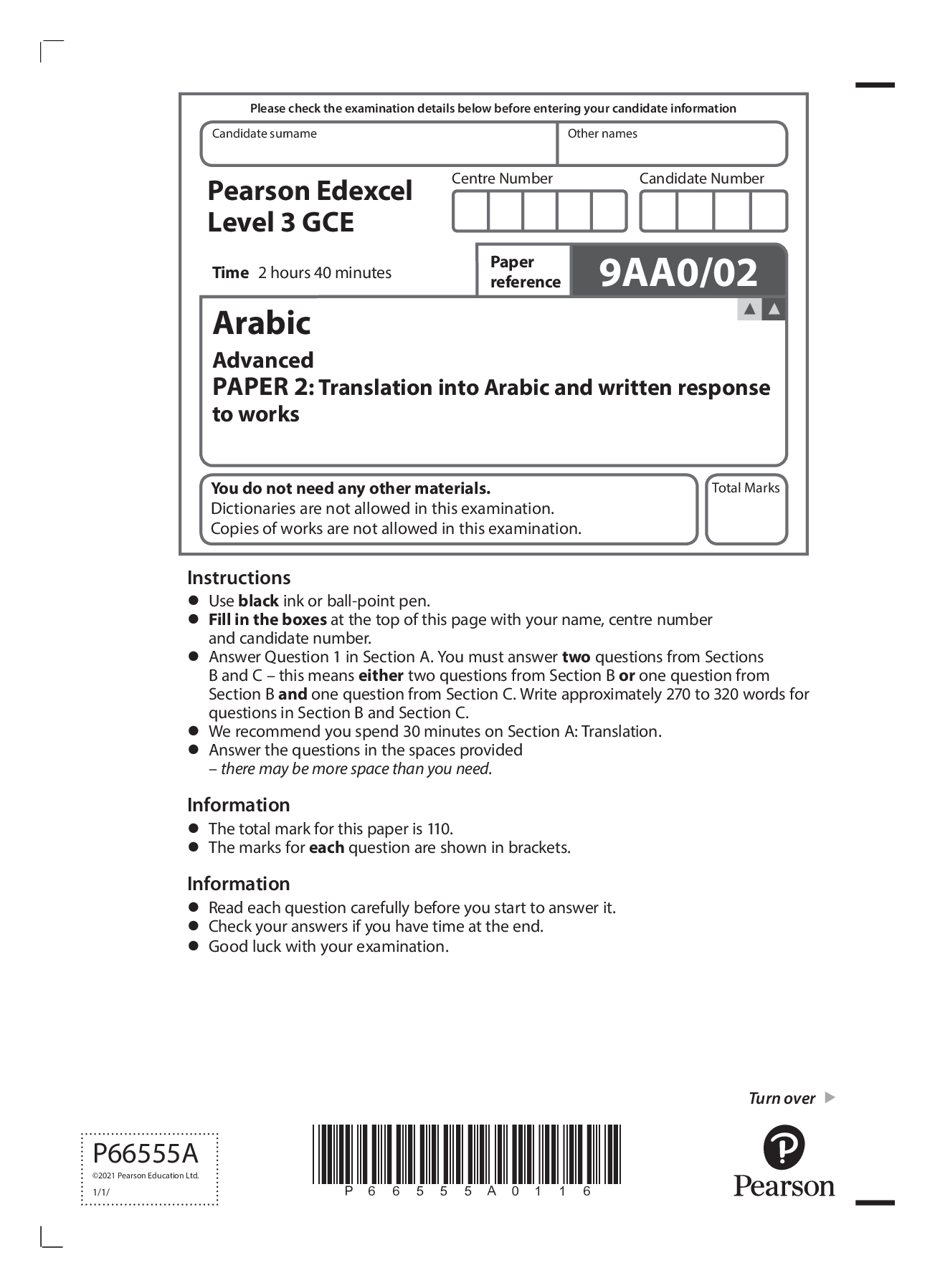
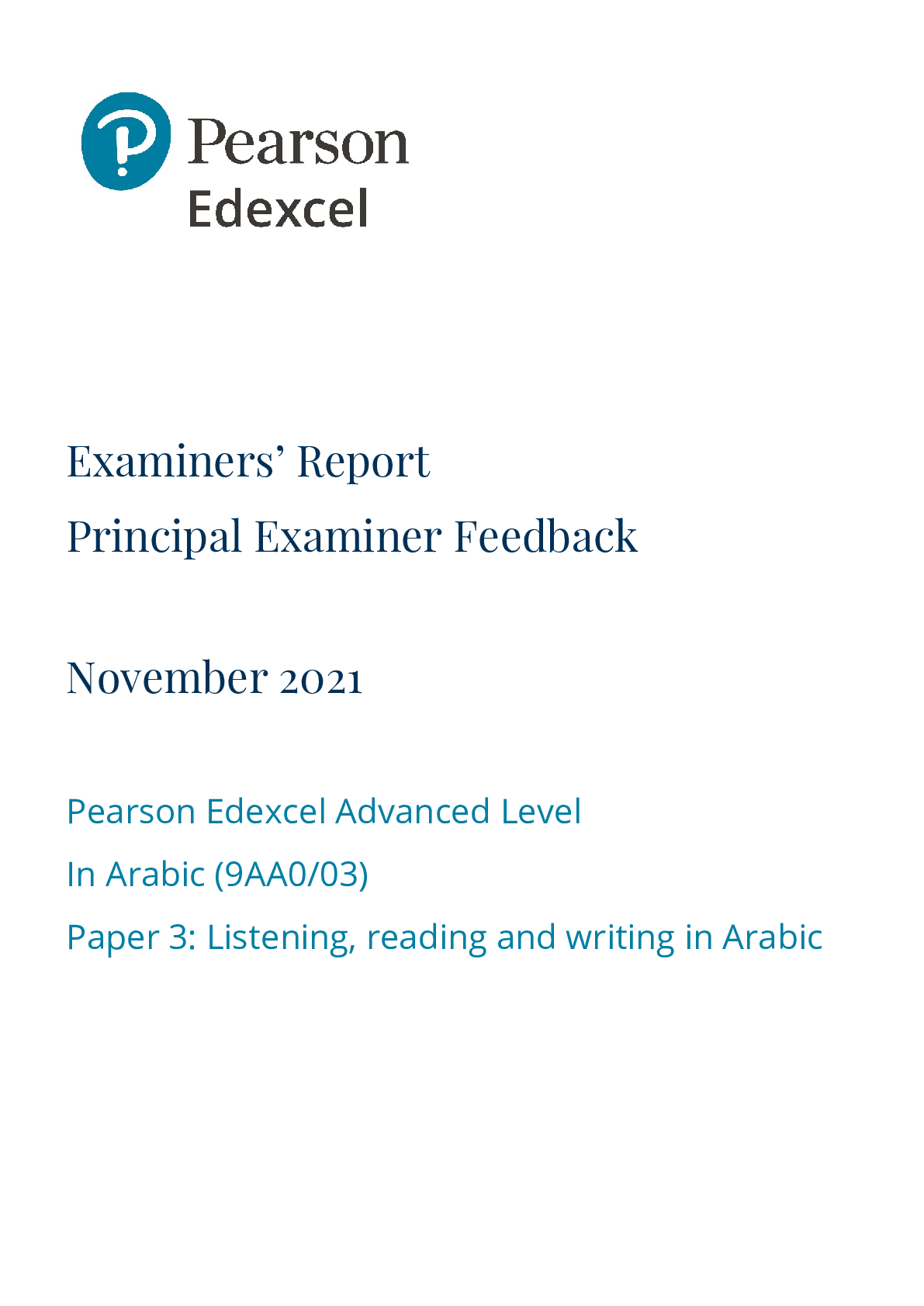
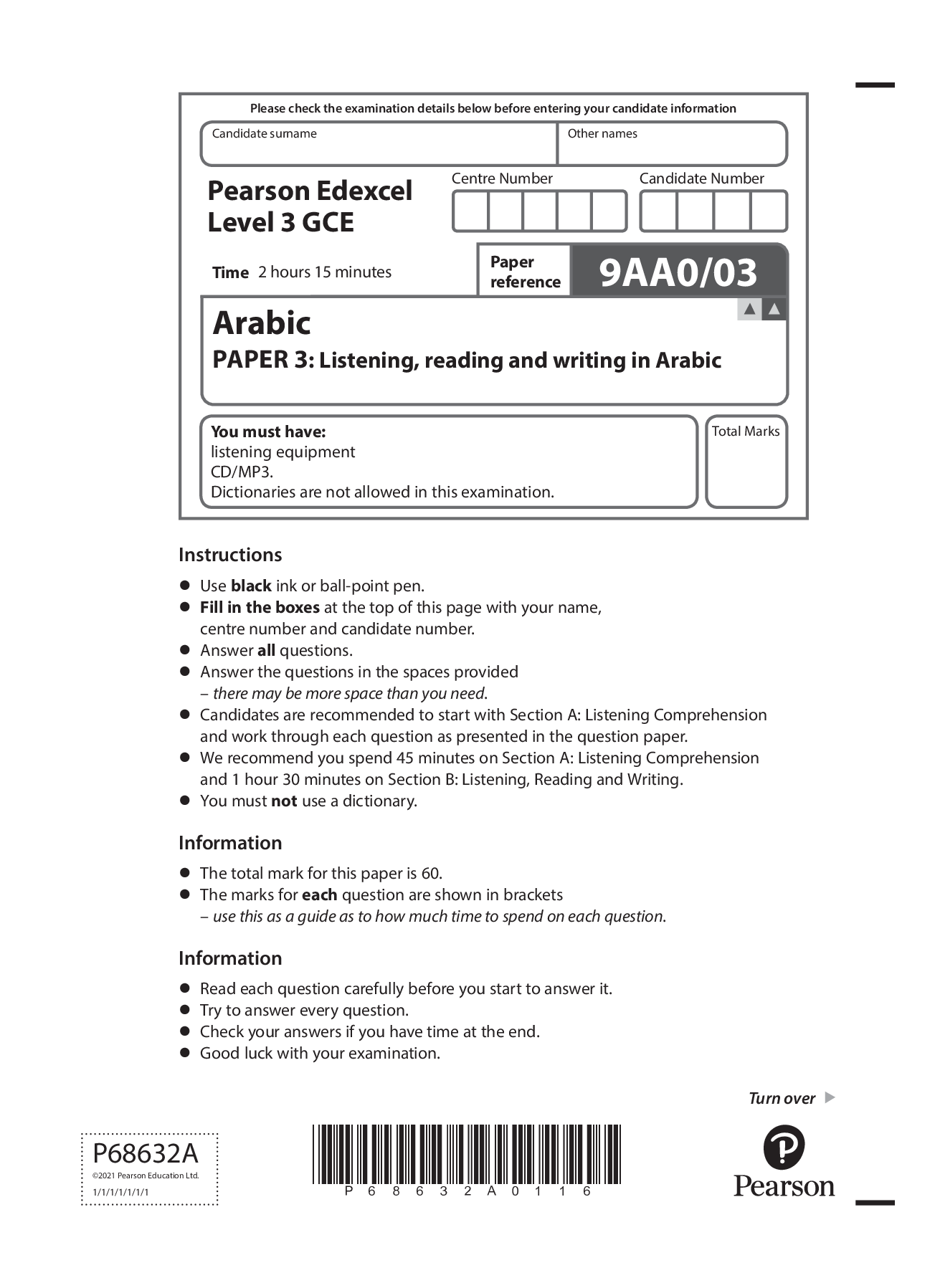
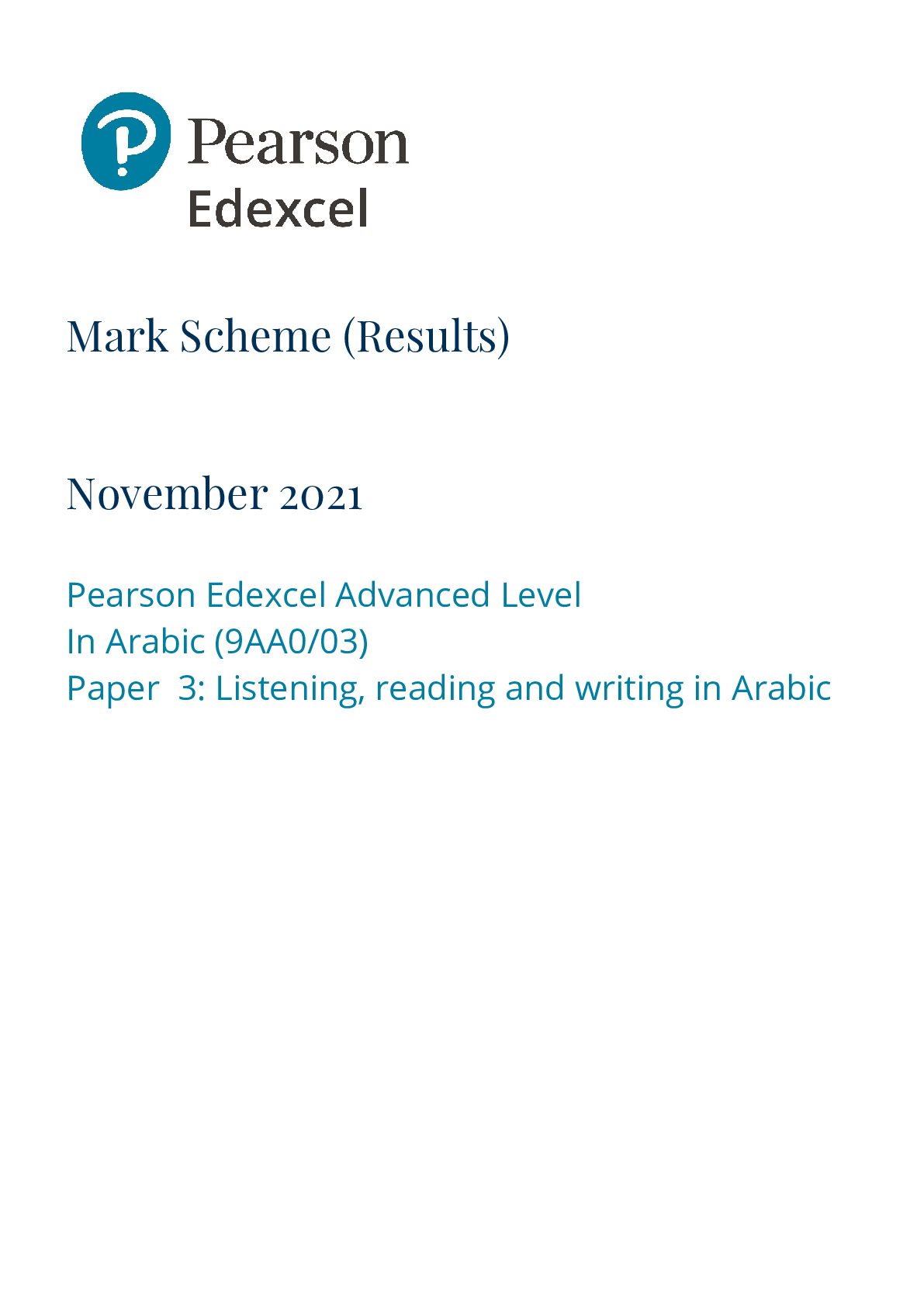


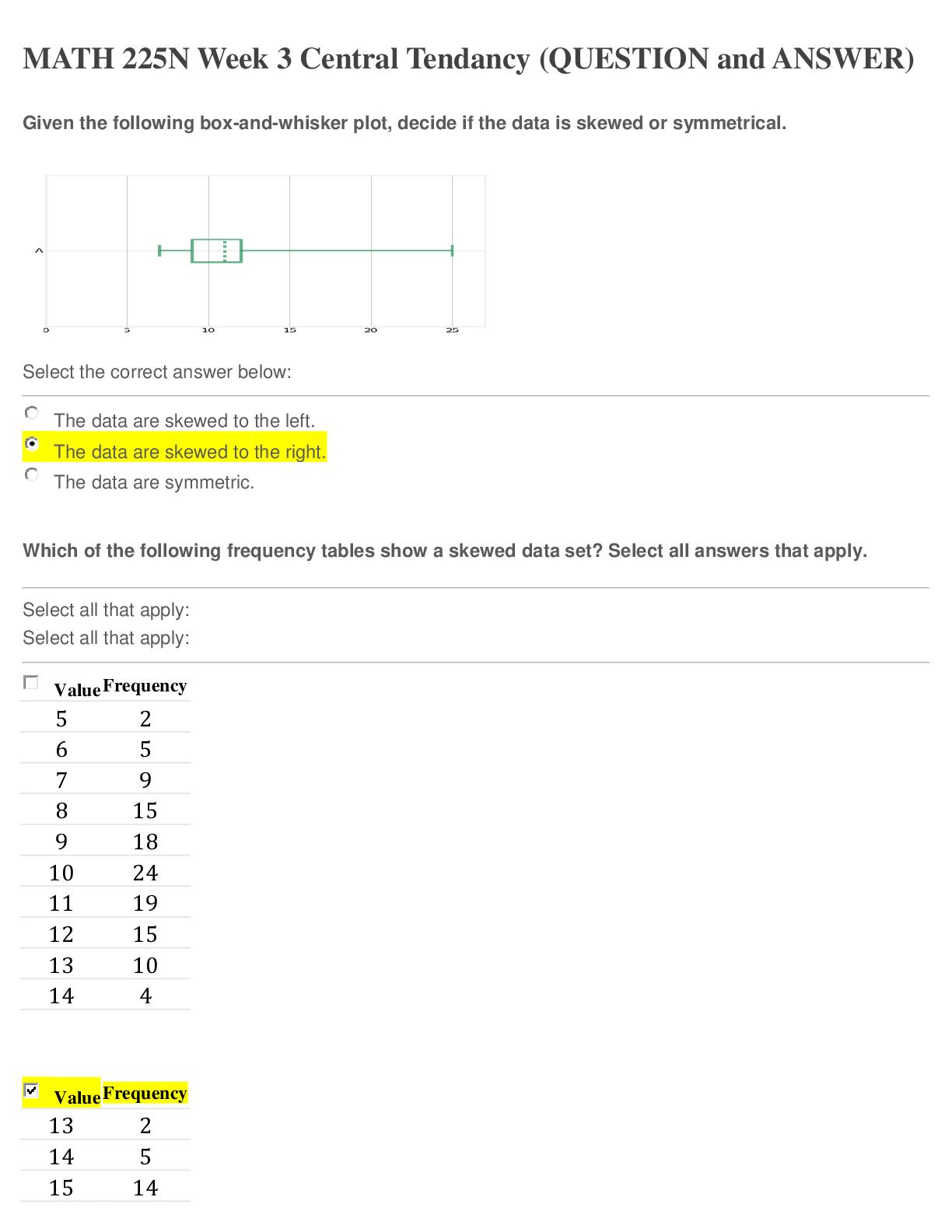
 _ Dermatology Prescription (100 Questions and Answers) – South University Savannah.png)
 Dermatology (64 questions and answers) – South University Savannah.png)
 Cardiovascular Assessment (107 Questions and Answers) – South university Savannah.png)
 CARDIOVASCULAR PRESRIBING (113 Questions and Answers) – South University Savannah.png)

